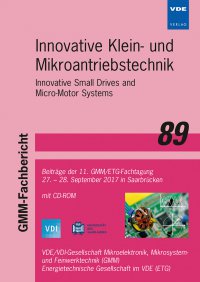Rotary Planar Actuator Using Mechanical Anisotropy of Tilted Carbon Fiber Arrays
Conference: Innovative Klein- und Mikroantriebstechnik - 11. GMM/ETG-Fachtagung
09/27/2017 - 09/28/2017 at Saarbrücken, Deutschland
Proceedings: Innovative Klein- und Mikroantriebstechnik
Pages: 5Language: englishTyp: PDF
Personal VDE Members are entitled to a 10% discount on this title
Authors:
Thiem, D.B.; Carrasco, A.; Schlaak, H. F. (Technische Universität Darmstadt, Institute of Electromechanical Design, Merckstr. 25, D-64283 Darmstadt, Germany)
Cardoletti, J.; Alff, L. (Technische Universität Darmstadt, Department of Material- and Geosciences, Alarich-Weiss-Str. 2, D-64287 Darmstadt, Germany)
Abstract:
Anisotropic friction generated by tilted carbon fiber arrays may be used to transform vibrations into a continuous motion of a rotor. This principle will be used in this work in a planar rotary motor with unimorph cantilevers as a vibration source. In this paper we research the deflection-force characteristics of the tilted carbon fiber arrays for the use in this motor. Therefore a measurement setup is introduced to quantify the generated friction force of the carbon fiber arrays. The measured deflection-force curves suggest a linear dependency starting at deflections of 100 µm. Below these deflections, the behavior of the arrays is measured to be nonlinear. A variation of the angle between the carbon fiber arrays and the contact surface below 3deg does not have an influence on the characteristic in this region of low deflections. Using the measurements and an electromechanical model, the desired cantilever geometries for the motor are derived. The optimized cantilevers are expected to reach deflections up to 90:5 µm. This results in the use of the non-linear segment in the beginning of the deflection-force characteristic of the carbon fiber arrays.


